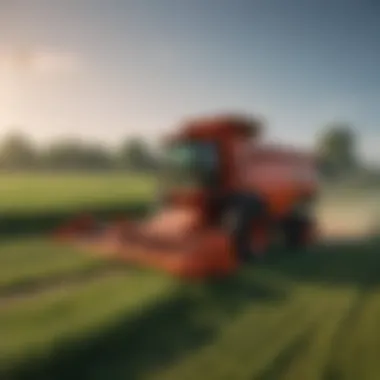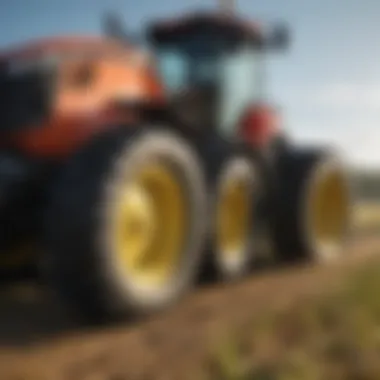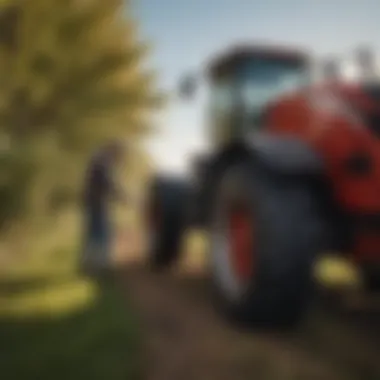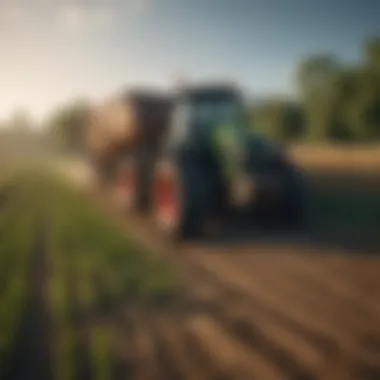Understanding Forage Machines: Innovations in Agriculture


Intro
Forage machines play an essential role in modern agriculture, aiding in the efficient production of feed for livestock. Understanding these machines is crucial for farmers, agronomists, and students interested in the agricultural field. This article aims to unpack the complexities of forage machines, focusing on their functionalities, technological advancements, and overall impact on efficiency and sustainability in agriculture.
Topic Overview
Understanding forage machinery begins with grasping their basic definitions and functionalities. These machines include devices such as forage harvesters, balers, and cultivators, all designed to optimize the foraging and harvesting process.
Definition of Key Terms
- Forage Harvester: A machine that cuts and chops forage crops for silage or direct feeding.
- Baler: A device that compresses cut crops into bales for easier transport and storage.
- Cultivator: Equipment used to prepare soil by loosening or aerating it, often before planting forage crops.
Relevance in Agriculture, Horticulture, and Agronomy
Forage machines significantly enhance productivity in agriculture by reducing the labor required for harvesting and processing feed. In horticulture, they contribute to soil management and crop health, promoting sustainable practices. Agronomists recognize the importance of these machines in creating a reliable source of animal feed and minimizing waste.
Current Trends and Innovations
The field of forage machinery is witnessing several exciting advancements. Increasing demand for efficient crop production drives innovation in this sector.
Recent Advancements in the Field
Focusing on performance and environmental impact, manufacturers have developed advanced forage machines that utilize precision agriculture techniques. These advancements optimize resource use, enabling more sustainable practices.
Emerging Technologies and Practices
Technologies such as GPS-guided forage harvesters and automated balers are making significant strides. These tools allow for better efficiency, reduced input costs, and lower environmental footprints. Smart technology helps farmers monitor machinery performance and crop health in real-time.
Practical Applications
Implementing forage machines can dramatically change farming operations. However, understanding the appropriate use of these machines is key to maximizing their benefits.
Step-by-Step Guides or How-Tos
- Assess Equipment Needs: Evaluate the size of your operation and type of crops grown.
- Select Appropriate Machinery: Research various models and choose the one that fits your needs.
- Regular Maintenance: Ensure regular checks of machine performance to avoid break-downs and prolong lifespan.
Tips and Best Practices for Implementation
- Schedule routine maintenance during off-seasons to prepare for peak times.
- Train staff on the operation and safety protocols involved with forage machines.
Understanding the technical aspects of forage machines can greatly enhance productivity. Proper training and good maintenance are essential for optimal performance.
By intimately knowing the functionalities and innovations within this field, agricultural practitioners can better adapt to evolving agricultural practices. The constant advancement in forage machinery fosters a more sustainable future towards food production.
Prelims to Forage Machines
Forage machines play a pivotal role in modern agricultural practices. As farmers strive for greater efficiency and productivity, understanding these machines becomes essential. Not only do they aid in the forage production process, they also influence overall farm management. The advancements in technology have transformed how these machines operate, leading to better efficiency and sustainability.
Definition and Overview
Forage machines refer to specialized equipment used to harvest and manage forage crops like hay, silage, and pasture. These machines encompass a variety of types, each designed for specific tasks within the forage production cycle. Key examples include mowers, rakes, forage harvesters, and balers. Each of these machines contributes to the overall objective of maximizing yield while minimizing labor and resource usage. Understanding the definition of forage machines provides foundation for comprehending their diverse applications in agriculture.
Importance in Agriculture
Forage machines are critical to agricultural success for several reasons:
- Efficiency: They allow farmers to accomplish tasks quicker compared to manual methods, leading to time and labor savings.
- Quality of Forage: Properly used machines ensure that the harvest maintains high nutritional quality, which is vital for livestock.
- Cost-Effective Operations: With the right machinery, farmers can reduce operational costs, making it economically viable to increase forage production.
In summary, the importance of forage machines cannot be overstated. They bridge the gap between traditional farming methods and the need for innovation in agriculture, ensuring that farming practices evolve to meet growing demands.


Types of Forage Machines
Forage machines serve as the backbone of modern agricultural practices, significantly enhancing productivity and efficiency. Understanding the types of forage machines is crucial for any agricultural professional or enthusiast. Each type caters to different stages of forage production, from harvesting to processing. This section evaluates key types and their operational characteristics, as well as their importance in streamlining farming activities, optimizing resource use, and improving overall crop yields.
Mowers and Conditioners
Mowers are fundamental in the forage production process. They serve to cut grass and legumes efficiently, preparing them for subsequent operations. Conditioners follow this step, playing a vital role in the drying process. They manipulate cut forage, creating optimal conditions for moisture reduction.
With advances in technology, modern mowers and conditioners utilize sophisticated cutting methods and adjustable settings. This enables operators to tailor machinery for different crop types and field conditions. The improved efficiency helps minimize waste while maximizing quality and yield.
Rakes
Rakes are essential machines for gathering cut forage into manageable rows, often referred to as windrows. This process facilitates easier harvesting by concentrating the material. Different types of rakes exist, including rotary and wheel rakes, each offering unique benefits based on the specific needs of the operation.
The choice of rake can significantly affect the speed and efficiency of gathering. Factors such as terrain, crop type, and moisture levels influence this decision. Proper utilization ensures less ground contact and minimizes dirt contamination, preserving forage quality.
Forage Harvesters
Forage harvesters represent a more complex and multifunctional piece of machinery. They serve to cut, chop, and deliver forage directly into storage systems or vehicles. This eliminates the need for multiple passes over a field, enhancing efficiency and reducing operational costs.
Modern forage harvesters come equipped with numerous features, including adjustable cutting heights and integration with precision agriculture technologies. As a result, they can efficiently handle various crop types, ensuring optimal harvesting across different conditions.
Balers
Balers come into play post-harvesting, binding forage into compact bales, which are more manageable for storage and transport. They provide a response to the need for ease of handling and long-lasting preservation of forage nutrients. Bales can be round or square, with each shape offering specific advantages depending on the intended storage and usage.
Technological advances in balers, such as the inclusion of moisture sensors and automatic tie systems, enhance the quality of the final bale while improving efficiency in operation. This equipment is crucial for farmers looking to optimize forage management and ensure livestock has access to high-quality feed throughout the year.
Operational Principles
Operational principles in forage machinery are essential for understanding how these complex systems work to optimize agricultural practices. This section delves into the detailed mechanics of forage production and examines the efficiency and speed achievable through various machinery. Mastery of these principles allows farmers and agricultural enthusiasts to enhance productivity while minimizing operational costs.
Mechanics of Forage Production
Forage production encompasses a series of mechanical operations, beginning from cutting to harvesting and storage. Different types of forage machines serve specific purposes throughout this process.
- Mowers and Conditioners: These machines cut the forage and condition it for drying, allowing moisture to escape efficiently. They usually have a series of blades or discs that ensure clean cuts.
- Rakes: Rakes gather cut forage into manageable windrows for easier collection. They work by using tines to lift the forage from the ground without causing damage to the plants.
- Forage Harvesters: These machines combine cutting, chopping, and loading forage into one operation. They are designed to handle bulk and are often equipped with various attachments to adjust to different types of forage.
- Balers: After harvesting, balers compress the forage into bales for easy transportation and storage. Making bales protects the forage from spoilage and simplifies the feed process for livestock.
Understanding these mechanics contributes to improved practices, enabling farmers to select the right machinery for their specific forage types. It is crucial to ensure that each machine operates correctly to reduce wear and tear while maximizing yield.
Efficiency and Speed in Operations
Efficiency and speed are vital for competitive farming. The advances in forage machinery have significantly enhanced these aspects. Factors contributing to operational efficiency include:
- Automation: Many modern machines include automated systems, enabling farmers to monitor performance and adjust settings in real-time. This reduces the need for manual intervention, allowing for consistent results.
- Integration with Precision Agriculture: Technologies such as GPS and data analytics have transformed the way forage machines operate. This integration ensures that operations like cutting and baling are done with minimal overlap, reducing time and resource wastage.
- Quality of Machinery: The reliability of forage machines impacts both speed and efficiency. High-quality machinery tends to require less maintenance, allowing for longer operation times and fewer interruptions.
Achieving high efficiency and speed results in significant cost savings, increased productivity, and better-quality forage. Operations that implement these principles can expect enhanced performance and sustainability.
"Efficiency in agricultural machinery leads to productivity gains that are essential for sustainable farming practices."
In concluding this section, the understanding of operational principles lays the foundation for successful forage production. By familiarizing themselves with the mechanics and efficiency of various forage machines, farmers can make informed decisions that benefit their agricultural practices.
Technological Advancements
Technological advancements in forage machinery play a crucial role in enhancing agricultural efficiency and productivity. These innovations respond to the increasing demand for food and necessitate improvements in how we manage our resources. The benefits of integrating new technologies into forage machinery encompass increased operational efficiency, improved product quality, and reduced environmental impact. Furthermore, these advancements not only simplify labor-intensive practices but also provide farmers with valuable data to support their decision-making.
Automation in Forage Machinery
Automation in forage machinery represents a significant leap forward for the agricultural sector. It involves the use of advanced robotics and control systems to perform tasks that were once labor-intensive. For instance, modern mowers and harvesters can operate autonomously, reducing the need for manual labor. This not only lowers operational costs but also allows for more precise management of resources.


The integration of automation in forage machines can enhance productivity. For example, an automated forage harvester can work continuously without fatigue. Additionally, advanced sensors and GPS technology improve their accuracy, ensuring that farmers maximize their yield.
Before implementing automation, farmers should consider some factors:
- Cost of investment: Initial costs can be high, but long-term savings may make it worthwhile.
- Technical know-how: Operators need to be trained for these advanced systems.
- Maintenance considerations: Maintenance routines can change with automated machinery.
Integration of Precision Agriculture Technologies
Precision agriculture involves using technology to measure and respond to variability in crop production. Incorporating precision agriculture technologies into forage equipment has transformed how those machines operate. This integration allows farmers to customize their approach, optimizing input use and increasing overall productivity.
For example, using drones and satellite imagery, farmers can analyze field conditions in real-time. This data can then be used to adjust the operation of forage machines, targeting specific areas that require more attention or resources.
Some noteworthy advantages include:
- Enhanced monitoring: Provides detailed insights into the condition of crops.
- Resource optimization: Minimizes waste of fertilizers and water, leading to more sustainable practices.
- Improved decision-making: Data-driven decisions can lead to better results in crop yields.
For farmers looking to improve their operations, exploring these technological advancements in forage machinery is essential. As the agricultural landscape continues to evolve, embracing innovation will be key to staying competitive in the market.
Maintenance of Forage Machines
The maintenance of forage machines is a crucial aspect of modern agriculture. Proper maintenance not only enhances the performance efficiency of the machines but also prolongs their lifespan, which ultimately translates to cost savings for farmers. Skipping regular maintenance can lead to breakdowns, which might halt operations and cause delays in harvest. Understanding the importance of maintenance practices offers a strategic advantage in the farming industry.
Regular checks and timely interventions keep forage machines operating at optimal levels. They also prevent unnecessary wear and tear. Thus, regular maintenance is not merely about fixing issues as they arise; it is about proactive care that helps in avoiding potential problems. This proactive approach can significantly enhance productivity during peak seasons.
Regular Maintenance Practices
Engaging in regular maintenance practices is essential. These should include:
- Daily Inspections: Before each use, inspect key components like blades, belts, and bolts to ensure everything functions correctly.
- Lubrication: Regularly lubricate moving parts to minimize friction and prevent wear. This is vital for longevity.
- Filter Checks: Clean or replace filters in engines and hydraulic systems as needed. Clogged filters can reduce efficiency.
- Blade Sharpening: Keep blades sharp for effective cutting. Dull blades require more power and can lead to plant damage.
- Cleaning: After each use, clean the machines to remove debris. This reduces corrosion and maintains machine integrity.
These steps contribute to seamless operations and help avoid costly repairs.
Troubleshooting Common Issues
Even with good maintenance, issues may still arise. Early detection is key to avoiding extensive damage. Common issues include:
- Engine Start Failures: Check fuel levels and battery conditions can quickly resolve this issue. If the battery is dead, jump-starting it may solve the problem.
- Poor Cutting Performance: This can result from dull blades or incorrect settings. Regular sharpening and adjustments are necessary to correct this.
- Hydraulic Problems: Leaks or insufficient fluid levels can hinder performance. Inspect hoses and fittings regularly.
- Vibration and Noise: Unusual noises or vibrations can indicate misalignment or component failure. Investigate promptly to determine the cause.
By being vigilant, operators can address problems before they escalate, ensuring smooth and uninterrupted operation.
Remember, proactive maintenance is always more cost-effective than reactive solutions. Adopting a disciplined approach to maintenance not only safeguards your investment but also enhances the resilience of your agricultural practices.
Impact on Sustainability
The use of forage machines in modern agriculture goes beyond mere efficiency; it directly contributes to sustainability efforts within the sector. Sustainable farming practices aim to minimize environmental harm, improve resource management, and enhance productivity in a way that can be maintained over the long term. Innovations in forage machinery are playing a crucial role in achieving these goals. They help reduce waste and promote energy efficiency, ultimately benefiting both farmers and the planet.
Reducing Waste in Forage Practices
Reducing waste is one of the fundamental elements of sustainable forage practices. Inefficient methods can lead to significant crop losses, impacting farm profitability and food supply. Forage machines, such as mowers and balers, are designed to optimize the harvesting process. For instance, modern mowers quickly cut grass, and conditioning processes prepare it for drying, reducing the chances of spoilage. As a result, farmers are able to maximize their yield and minimize waste.
Additionally, forage harvesters collect every part of the plant, ensuring that virtually no material is left behind. This efficiency not only leads to higher productivity but also assists in managing crop residues. Moreover, well-maintained machinery is less prone to breakdowns, meaning less environmental waste associated with replacing parts or the entire machine.
Energy Efficiency and Resource Management
Energy efficiency is a major factor in sustainability. Advanced forage machines are often equipped with features that promote fuel savings. For example, many models incorporate GPS technology that assists in precise navigation, which can reduce overlap during operations. This precision translates into lower fuel consumption and reduced emissions, making farming activities greener.
Furthermore, innovations such as electric-powered forage machinery are emerging. These machines can operate at lower operational costs compared to traditional fuel-based ones. While still in the infancy stage, their potential for widespread use may significantly influence how future agricultural practices evolve. By utilizing energy-efficient machinery, farmers can achieve better resource management and lessen their carbon footprint.
"Sustainability in agriculture is not just about the environment; it is also about ensuring that farming remains a viable profession for future generations."


In summary, the impact of forage machines on sustainability is multi-layered. From waste reduction through efficient harvesting to advancements in energy use, these machines are transforming agricultural practices. As technology continues to evolve, the integration of sustainable practices in farming will likely become even more enhanced.
Regional Variations in Forage Machine Use
Understanding regional variations in forage machine use is vital for agricultural success. Each region has its unique climate, crops, and farming traditions. These factors heavily influence what type of machinery is favored. Adapting to these variations means better efficiency and productivity for farmers.
Adaptations to Local Climates
Adapting forage machines to local climates hás a direct impact on their effectiveness. For example, areas with heavy rainfall require machines that can operate in wet conditions without getting bogged down. Therefore, certain mowers and rakes are designed with larger tires and higher ground clearance for better mobility. Conversely, in drier climates, machines might be optimized for speed and fuel efficiency. This means they may use lightweight materials and advanced cutting technologies.
Farmers also consider other climatic factors such as temperature and humidity. For instance, in regions with high humidity, moisture retention is crucial for forage quality. This prompts the use of machines with innovative conditioning features that ensure drying without losing nutrients. Thus, local climate adaptations ensure that forage machinery aligns with agricultural practices that optimize yield and quality.
Cultural Practices Influencing Equipment Choice
Cultural practices play a significant role in determining the forage equipment used in various regions. These practices often stem from long-held traditions and community knowledge. For instance, some cultures may favor specific types of forage crops, leading to a unique set of tools being favored in that region. In regions where hay production is emphasized, large round balers might be prevalent as they cater to the efficient storage and handling of hay.
Furthermore, local labor availability can greatly influence equipment choice. In regions with a surplus of labor, farmers might opt for equipment that requires more manual input, whereas in areas with limited labor, machinery that provides automation is preferred. Farmers often share resources and knowledge through community practices, leading to a localized understanding of what works best.
"Understanding regional variations is not merely about machinery; it's about aligning practices with the land and culture."
Cultural preferences can also dictate aesthetics, such as color and design of machines. While these factors might appear trivial, they reinforce the importance of cultural identity within agricultural practices. Therefore, farmers must consider both practical applications and local customs when selecting forage machinery.
Future Trends in Forage Machinery
The landscape of forage machinery is changing. As farmers strive for efficiency and sustainability, innovations in technology have become crucial. This section weighs the future trends in forage machinery, highlighting how they can improve agricultural practices.
Emerging Technologies and Innovations
Emerging technologies are critical in shaping the future of forage machinery. These innovations come in many forms, including automation, remote sensing, and data analytics. Automation can reduce labor needs, allowing operators to focus on management tasks. For instance, robotic mowers can handle grass cutting with little human intervention.
Remote sensing technologies are becoming widely available, making it easier to monitor crop health and soil conditions. Drones equipped with cameras can survey fields quickly, providing valuable data for decision-making. This leads to more targeted interventions, enhancing efficiency in forage production.
Data analytics is another area where innovation is taking place. By processing large amounts of data, farmers can forecast yields accurately and optimize input usage. This not only enhances productivity but also minimizes waste, which is increasingly important for sustainable farming.
Predictions for Market Growth
Market growth in forage machinery is expected to rise significantly in the coming years. Several factors contribute to this growth, including rising global food demand and the need for more sustainable practices. As populations grow, there will be increased pressure on agricultural systems. This makes efficient forage production critical.
In addition, as technology becomes more affordable and accessible, more farmers will adopt advanced equipment. Agricultural machinery manufacturers are already investing heavily in research and development, aiming to produce smarter and more efficient machines.
According to recent market analysis, the global forage machinery market is projected to expand at a rate of around 5% annually through the next decade. This trend indicates a robust interest in innovation as farmers seek ways to enhance their operations.
"The future of forage machines will define how effectively and sustainably we can manage agricultural practices in a rapidly changing environment."
By understanding these trends, farmers and agricultural professionals can better prepare for the future. Staying informed about new technologies and market dynamics is essential for competitive agriculture.
Epilogue
The significance of this conclusion lies in the synthesis of concepts explored throughout the article. Understanding forage machines extends beyond their mechanics and operational principles. These machines are a cornerstone of modern agriculture, enhancing productivity and sustainability. In this section, we will encapsulate the crucial elements, benefits, and considerations related to these technologies and their impact on agricultural practices.
Summary of Key Points
The exploration of forage machines reveals several critical insights:
- Types of Forage Machines: Several types, including mowers, rakes, and balers, contribute uniquely to the forage production process.
- Operational Principles: Knowledge of how these machines operate increases efficiency in production cycles.
- Technological Advancements: Automation and precision agriculture technologies significantly enhance the effectiveness of forage machinery.
- Maintenance Practices: Regular upkeep of these machines is essential to prevent downtime and ensure optimal functionality.
- Sustainability Impact: Properly utilized forage machines can minimize waste and promote energy efficiency.
- Regional Variations: Different geographic areas adapt machinery to local climates and cultural practices, showcasing flexibility in usage.
- Future Trends: Emerging technologies hint at even more innovations in the forage machinery sector, which points to a growing future in this field.
These points not only illustrate the advancements made but also emphasize the pivotal role forage machines play in the agricultural landscape.
Final Thoughts on Forage Machinery's Role in Agriculture
In summation, forage machinery is not just a tool but a vital element in the ecosystem of modern farming. Farmers and agricultural practitioners who understand the intricacies of these machines can leverage their capabilities to maximize outputs while minimizing environmental impact. The advancements in technology will continue to shape the future of agricultural practices, allowing farmers to keep pace with growing demands on food production. Keeping abreast of ongoing innovations will be crucial for those looking to optimize their practices effectively.
The future of agriculture relies heavily on the efficient integration of advanced technologies that ensure sustainable production methods.
As we look forward, it is essential to encourage further dialogue about the role of forage machinery in agriculture. By sharing experiences and knowledge, the agricultural community can better adapt to the rapidly changing demands of farming.



